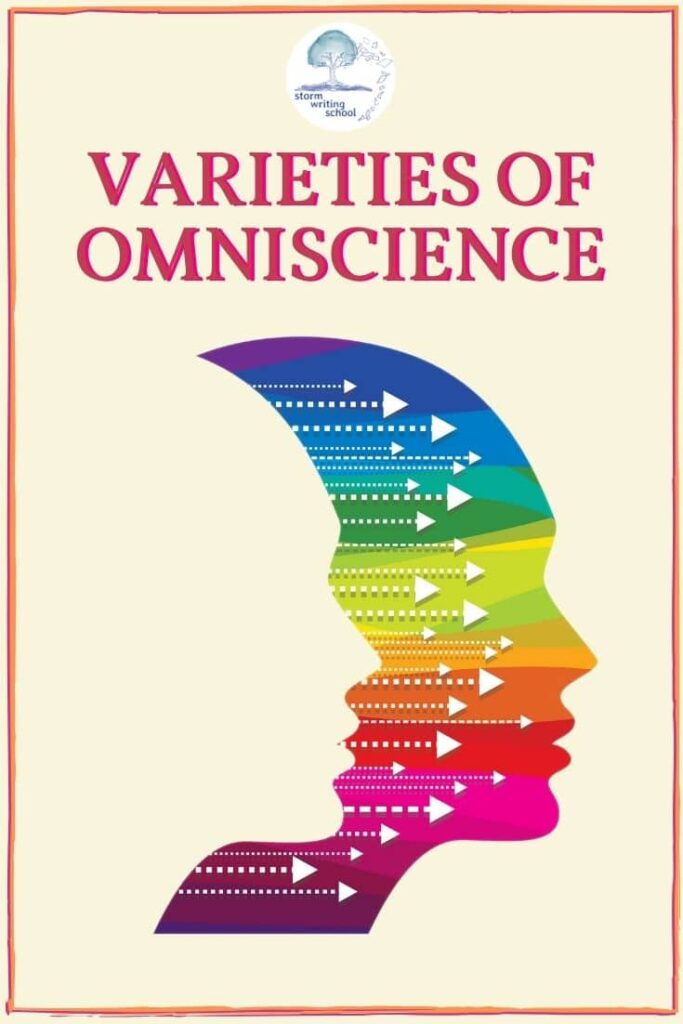Omniscience is a curious term. “All knowing,” it means. On the one hand, it seems a ridiculous label for any human. Nobody can truly know all, right? And yet, it also feels natural to call any storyteller all-knowing when it comes to the story they’re conveying. As the writer, you are the god of your story, after all.
But of course, if we’re being precise, omniscience is a narrator thing, not a writer thing—the difference being that a narrator may or may not be situated to know everything within the world of the story, even if the writer does. Omniscience—or any POV, really—is all about how the writer situates the narrator in relation to the character(s).

The Prominence of “Limited”
Stories in the past 100 years or so have tended toward “limited” narration, which positions the narrator as having access to only one person in any given scene. Generally, that limiting allows for greater intimacy with the character whose perspective is narrated. We gain more empathy with an individual when we are allowed to see things only as they see them, complete with all their flaws and limitations.
Take a child protagonist, for instance. In Mark Richard’s “This Is Us, Excellent,” the narration is voicey (it’s first person, but it could remain pretty similar and certainly very voicey in third person) and full of dramatic irony:
My brother and I have been having off from school. Our mom won’t let us go because of my black eye. I took it like a Duke McQuaid. I like to look at myself in the mirror and then spit in the sink like it ain’t nothing to it at all.
We are at home alone so when we see the lady next door going up her walk my brother and I put our mouths up to the window shade and yell, Nosy Bitch! Then we lay down on the company sofa we’re not allowed on and laugh. Our dad has said that Nosy Bitch was the one who called our school. They took us in the sick room and asked us was everything all right at home, did we tend to fall down and hurt ourselves. I told them our dad can beat up whoever he wants to. Nosy Bitch!
Limiting the narration feels almost essential for a story like this, and limited narration is hard to beat if the goal is to give an in-depth view of a character’s internal workings.
Omniscient Comeback?
But omniscient may be making somewhat of a comeback. I’ve read several very recent novels written in omniscient narration. As this NY Times article speculates, perhaps the rise in omniscience has to do with our technologically-infused society, the lessening of privacy and the information age’s obsession with examining big-picture trends. Who know?
Regardless of what’s driving the rise of omniscience, one thing has become clear to me: not all omniscient approaches are created equal. That is, even within the umbrella of “omniscience,” there are several variations.
Clarification: Limited vs. Limited Omniscient
I should say, though, before I go on, that in some texts on writing craft, you may come across the term “limited omniscience,” which is just what we call “limited” narration. That’s confusing, isn’t it? The logic is that the so-called “limited omniscient” narrator knows all that a single character thinks or feels.
But let’s strike that label from our lexicon, okay? We’re talking about limited OR omniscient. I’m going to stick with “limited” for the one-scene-one-character narrative approach and omniscient for the more-than-one-perspective-in-any-given-scene approach.
Dimensions
So let me introduce the concept that different omniscient narrators may have different breadths and depths to their narration. Omniscient narrators may appear at almost any position within the following graphic. The leftmost line is the what I call the Limited Line; the depth of narration can still vary along that line, but there is only one character’s perspective being shared. All omniscient narration is to the right of the Limited Line.

Breadth
By breadth, I mean, basically, the number of characters the narrator has access to. How many heads they can get into.
Some omniscient books give us glimpses of other perspectives here and there but remain for the most part in one head. Victor LaValle’s The Changeling is an example. We mostly stick to the perspective of the protagonist, Apollo. But the book begins with an omniscient prologue of sorts and also gives us brief perspectives of other characters adjacent to Apollo (his mother, his wife, his sister-in-law). Pride and Prejudice mostly sides with Elizabeth Bennet, but it’s not exclusively her perspective that we get.
On the other end of the spectrum, Leave the World Behind, by Rumaan Alam, has an admittedly small cast (just six characters, really), but it frequently gives us many perspectives within a single scene. So that’s a greater breadth of omniscience. In books with a large breadth, it can be hard to even single out a primary protagonist.
Clarification: Multiple Viewpoint vs. Omniscient
I should clarify, too, that I define omniscience as narration that can delve into more than one character in any given scene. This is different from multiple viewpoint or roving. Multiple viewpoint stories are still limited. They always stick to a single viewpoint in any given scene or chapter.
So breadth is not about how many characters’ viewpoints we get within the book. It’s about whether the narrator can cover a multiplicity of viewpoints within a single scene, and if so, how many. Breadth is about the narrator’s freedom of movement (from one head to another) and how often they exercise that freedom of movement.
Depth
The other dimension of omniscience is depth. Depth is about how intimate the narrator is with the characters. Classic omniscience tends to be a little more distant with characters; that is, it doesn’t necessarily go very far into their emotions and thoughts.
Dickens is quite skilled at giving us insight into characters mostly from an external view of them. In fact, the default approach of most 19th century novelists was a relatively external omniscience.
Modern omniscient craves the freedom to explore more deeply, though. And so you may see much greater depth in recent novels that take the omniscient approach.
Examples
Now, I don’t pretend this is math or science. I’m not at all interested in assigning a numerical value to a book’s depth or breadth. But you can see what I mean through a comparative analysis of the two fairly recent books I mentioned above: Victor LaValle’s The Changeling (2017) and Rumaan Alam’s Leave the World Behind (2020).
The Changeling
If you open up to any random page of The Changeling, you’ll assume the POV is limited. I had to search for scenes that gave us more than one perspective, but they are there, peppered throughout the narrative. Take, for example, these two paragraphs, which I would flag as a “POV violation” were this a limited story:
Emma swayed where she stood, and her cheeks puffed out, and she brought one hand over her lips. He braced his body around hers trying to keep her as steady as possible. He wasn’t sure what they’d do if she vomited. Who would the remaining few passengers in the car hate more at that point—the dancers or the couple covered in puke? Ah, New York.
At West 4th Street, Apollo set Emma down onto the gray plastic corner seat gently. But as soon as she sat—her full weight going down on her tailbone—she lurched forward again, her face tight with concentration. It hurt to sit, but if she stood she’d throw up, and they had ten more stops to go.
In the first of those two paragraphs, we get a “he wasn’t sure.” That’s internal stuff there, only accessible to narrator who knows Apollo’s mind. But then in the second paragraph, we get “It hurt to sit, but if she stood she’d throw up,” which is Emma’s mind. We’re solidly in omniscient here.
But LaValle mostly sticks with Apollo, so the any-random-page trick will usually land you at something like this:
Patrice left the store with a half-dozen bags in hand while Apollo carried only a rolled-up dirty diaper.
“You and Dana should think about having a kid,” Apollo said as they walked down the block.
He’d regretted it right after the words left his lips. It was a dick thing to say. He knew it. Didn’t he hate it when people on the streets offered unsolicited advice about how he should be caring for Brian? Old women scolded him for not covering him up, and others demanded he be uncovered. Old men jabbered about how best to burp or bounce or feed the child. Didn’t he loathe even those with the best intentions? But then he’d done something like it to Patrice. Maybe having a child was like being drunk. You couldn’t gauge when you went from being charming to being an asshole.
“You’re right about that,” Patrice said. “If we don’t have kids, how will I ever know the joy of carrying a handful of shit?”
We’re tracking Apollo’s state of mind throughout the majority of the story, and the narration occasionally goes pretty close. LaValle generally avoids long passages of interiority/reflection, but we get fairly intimate with Apollo. I’d maybe plot this book as somewhere around here:

Leave the World Behind
In contrast to The Changeling, Leave the World Behind has much greater breadth and not quite as much depth. We occasionally read full pages of interiority, but very little of it is all that revealing. Ultimately, the characters come across as types. Complex and fleshed out types, but types nonetheless.
In the following example, we can see into the minds of four characters within five paragraphs:
Amanda wanted to send the children out of the room, but there was no television to distract them. “Archie, why don’t you go put on your clothes.” Her hand on his gritty back. He was hot to the touch. “Drink more water. Maybe you should take a shower?”
Ruth understood; maybe any parent would. “Rose, maybe you should go lie down.”
The girl didn’t know if this strange woman was meant to be obeyed. She looked up at her mother to see what to do.
“That’s a good idea, honey.” Amanda was grateful. “Go curl up in Mommy’s bed. Read your book.”
“I’m going to go take a shower.” Archie was suddenly conscious of being undressed. He couldn’t confess to this, but he’d pissed in his swimsuit.
I’m guessing that out of context, this is even a little hard to follow. It would certainly be easier if you’d been eased into this level of breadth from the start of the novel rather than dropped in like I’ve done to you here.
But regardless, you see what I’m saying, yeah? Look at the verbs that reveal a narrator seeing inside a character: “Amanda wanted,” “Ruth understood,” “the girl didn’t know,” “Amanda was grateful,” “Archie was suddenly conscious.”
None of that interiority goes all that deep. But it certainly goes wide. I’d plot this passage somewhere around here:

So this is all something to keep in mind if you ever tackle omniscient. Read several omniscient books and see where you think the authors land on the breadth/depth chart. There’s no one right way to do omniscience, but you’ll likely find some approaches are more comfortable for you than others.








4 Responses
I am peeved when we suddenly break POV to hear inside another character’s head. Often it feels like an error rather than intentional. I think I generally prefer books with one POV, or different chapters/sections for each POV.
However… lately I notice tons of contemporary books with alternating POVs by chapters. I think this can be tricky to pull off.
Yeah, omniscient is not for everyone. And to be honest, Leave the World Behind didn’t always transition well between characters. But I occasionally come across an omniscient story that does it so well that I don’t even realize it’s omniscient until after a few dozen pages. That’s the gold standard. Multiple viewpoint (alternating POVs by chapters) is less tricky than omniscient, I’d argue. But it’s all hard. 🙂 🙁
I am pleased to hear that omniscient narration is still alive and well. In my opinion, Deep POV is a good skill to learn as a writer for intimate or emotionally charged scenes. However, I find it tedious and limiting when I want my readers to know something the POV character herself doesn’t know. In that instance, an omniscient narrator can help build suspense.
Yes! There are definitely some compelling reasons to go with omniscience for some stories.